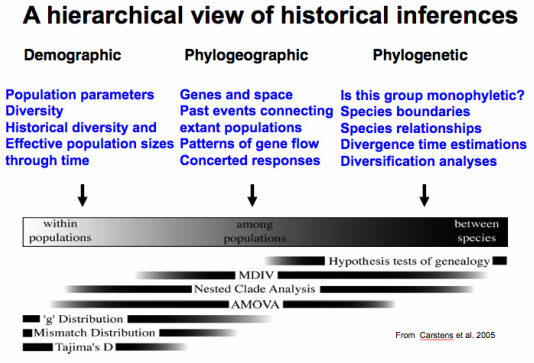From Ecological to Evolutionary timescales

My research is focused on the inference of past events that may have shaped the evolution of single or multiple lineages.
These historical events can be demographic, i.e., at a 'ecological' timescale. For example, the inference of recent spatial range shifts based on genetic markers. Usually, the process of genetic divergence within a single lineage 'anagenesis' is studied applying population genetics approaches.
Studying divergence through time also means inferring events that happened before the origin of a particular lineage or species i.e., within an evolutionary time scale. Here potential inferences concern the time and mode of species origination.
Studying the evolutionary history of any organism or group of organisms, can also be simply defined by the markers being used to infer these events. Although, all and genetic marker will track past history, they do so at a different pace, and thus they 'track' events happening at different time slices.
Genetic Markers that evolve -mutate- very fast, such as single tandem repeats (microsatellites), or some stretches of non-coding DNA are useful to track events or relationships at a ecological timescale. For example, microsatellite loci can be used to assess fluctuations in population size, parent-offspring relationships (Benavides et al., 2012), or to infer situations where population admixture has played a role in shaping genetic diversity (Garrick et al., 2014). In contrast, nuclear exons and ribosomal genes will track much more older events since they accumulate mutations at a slower rate (Benavides et al., 2007). Nuclear and mitochondrial genetic markers can be used to infer phylogenetic relationships, divergence times among lineages of a particular clade (Benavides et al., 2009) or infer the evolution of 'traits' of interest.
I have used the whole range of genetic markers available to infer past history at both ends of the spectrum, and consequently applied widely different inference methods. Interestingly, all these statistics are still trying to infer a rather limited number of population parameters. How you do it, and perhaps equally important, how you reduce the error associated to any historical inference is in the end the unifying goal.
The figure on the top, gives a snapshot of how we define genetic divergence at different time scales, and what type of methods we use to interrogate DNA for answers.
